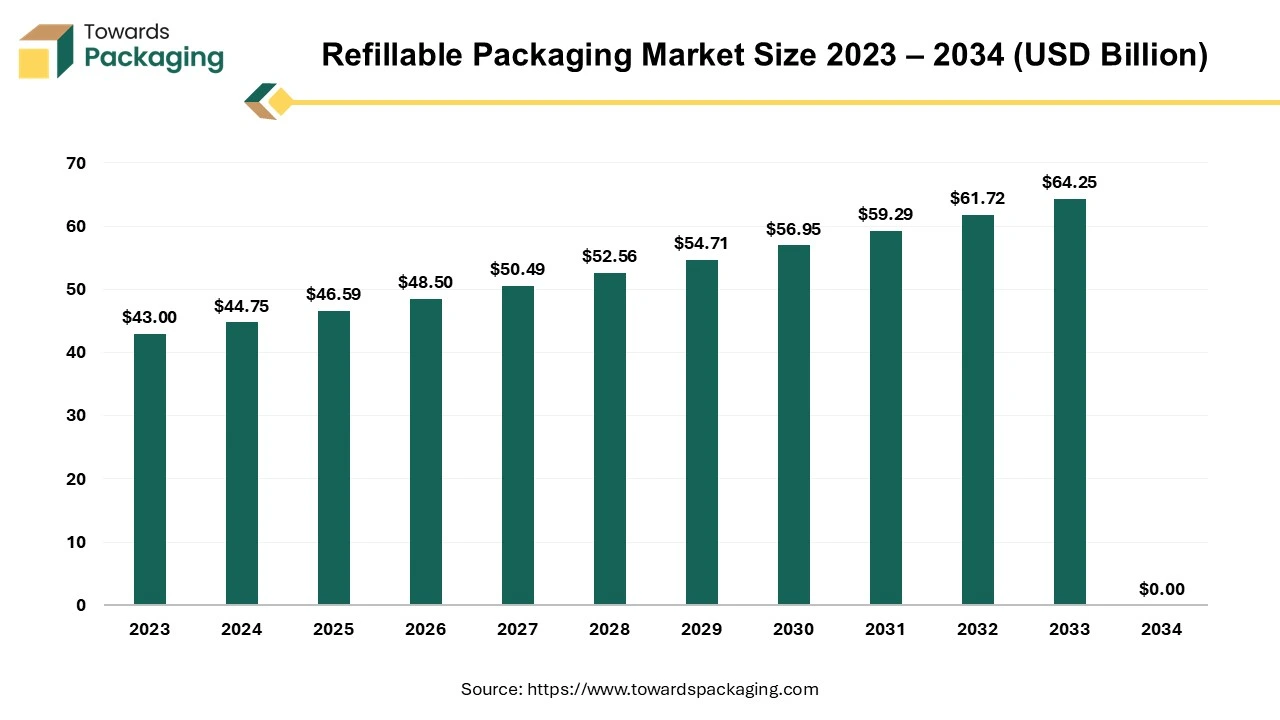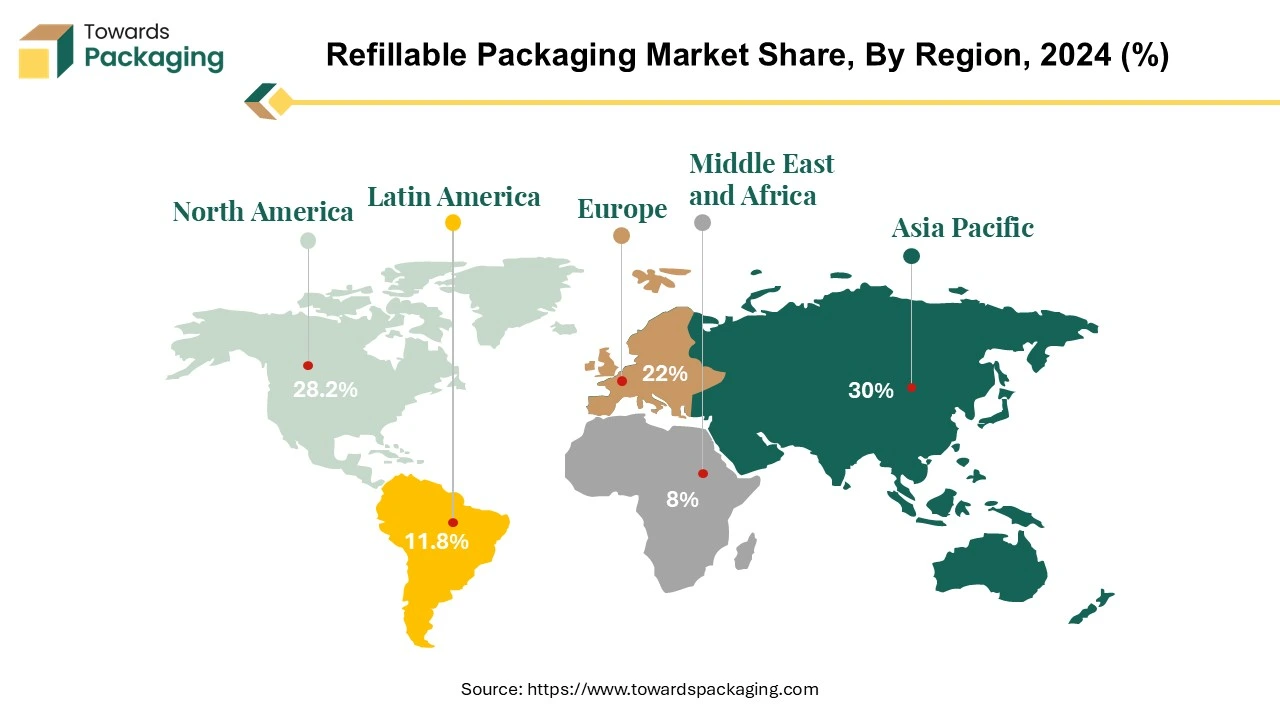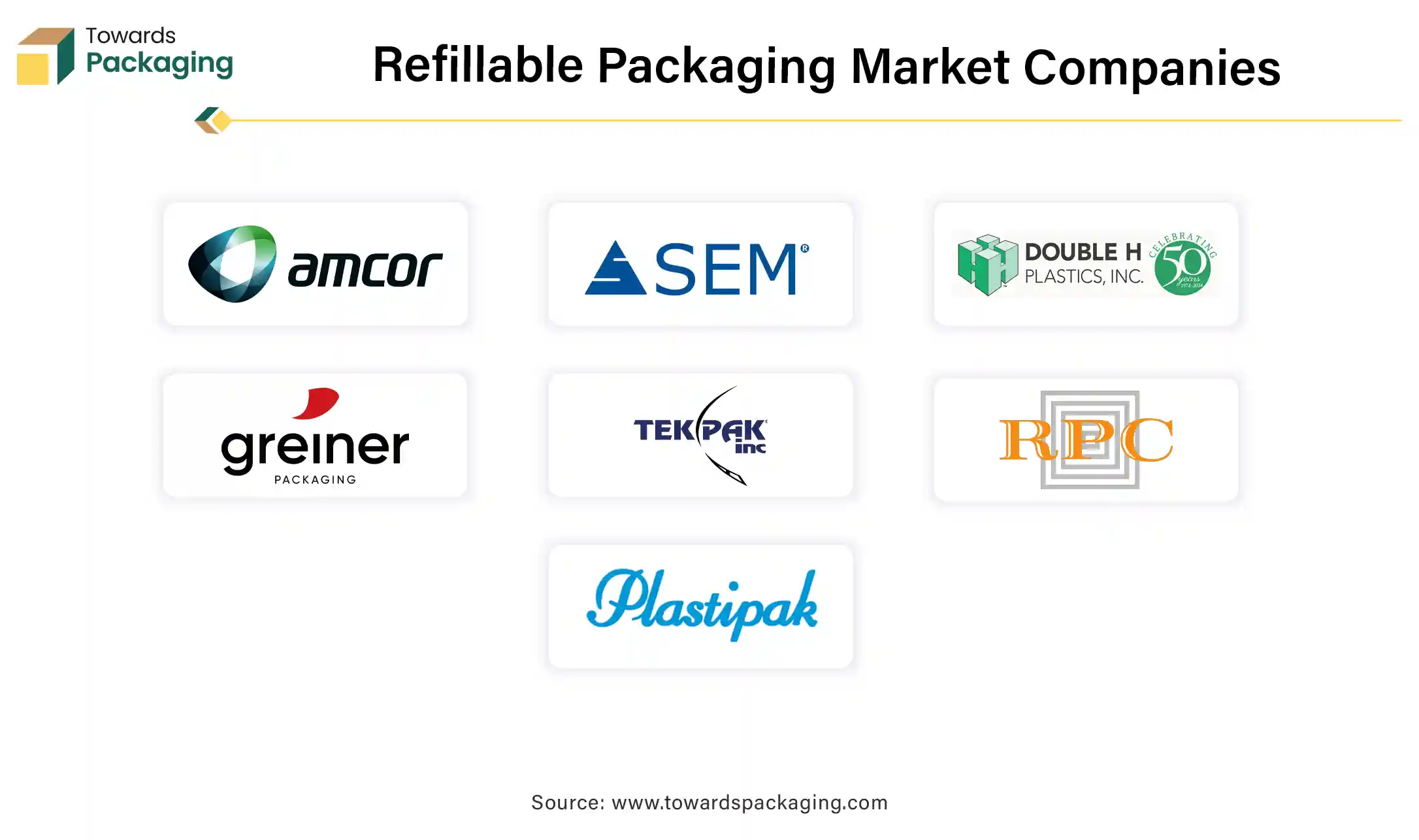April 2025
The refillable packaging market size is expected to increase from USD 46.59 billion in 2025 to USD 64.25 billion by 2034, growing at a CAGR of 4.1% throughout the forecast period from 2025 to 2034.

Refillable packaging market describes the packaging business area that concentrates on creating, manufacturing, and marketing packaging solutions made to be refilled with products. Refillable packaging offers containers that may be filled with the original product several times, reducing the amount of waste from single-use items and their adverse environmental effects. Food and beverage containers, household cleansers, personal hygiene products, and other consumables are just a few of the businesses and goods that make up this market. Refillable packaging usually incorporates a system where customers may buy refill packs to fill their current containers or return empty ones to be replenished. The objective is to lessen the quantity of packaging waste produced and encourage a more circular and sustainable consumption.
| Trends | |
| Expansion Across Various Industries | The refillable packaging is becoming increasingly popular in various industries, such as food and beverage, household cleaning products, and personal care. Refillable packaging models are gaining popularity among businesses, and as more sectors look at environmentally friendly packaging solutions, this trend will probably continue |
| Innovations in Design and Material | Refillable packaging is constantly evolving in terms of both material and design. Manufacturers are investigating materials that are lightweight, strong, and reusable. Innovative and appealing designs improve the consumer experience in general and promote the use of refillable container options. |
| Retailer and Brand Initiatives | Retailers and businesses actively promote refill stations and refillable packaging choice to reduce single-use packaging. Retailers and packaging producer collaborate to develop easily accessible refill systems, encouraging customers to make sustainable decisions. |
| Rising Demand for Sustainable Solutions | Demand for sustainable packaging choices rises as people become more conscious of environmental issues. Reusable containers that encourage refilling are becoming increasing popular as an environmentally preferable substitute for single-use packaging. Customers are actively looking for goods that have a minor environmental impact. |

The Asia-Pacific area has become an established leader in the refillable packaging industry due to reasons highlighting the region's environmental care and commitment to sustainable practices. Growing awareness and concern for ecological conservation drive the Asia-Pacific market's dominance in refillable packaging. The need for eco-friendly substitutes for conventional packaging is rising as customers grow more mindful of the environment, and refillable choices stand out as a sustainable option. Government initiatives and legislation have primarily facilitated the expansion of the refillable packaging industry in the Asia-Pacific region. Many nations in the area have enacted strict environmental regulations, encouraging companies to use sustainable packaging techniques. The market is expanding due to the legislative push that has encouraged using refillable packaging solutions in various industries.
The Asia-Pacific area has aided market growth for refillable packaging. Customers in the region are eager to spend money on goods and companies that share their environmental ideals because of the fast- expanding middle class and rising disposable incomes. To meet the changing needs of the discriminating Asia-Pacific customer, businesses have been compelled to include refillable packaging choices in their product offers. Refillable packaging is leading the Asia-Pacific region, and this can be ascribed to economic factors, consumer awareness, and legislative backing. The area is well-positioned to lead the global transition towards more ecologically friendly packaging options as sustainability continues to gain traction.
The refillable packaging market has witnessed a significant movement towards sustainable practices and environmental responsibility, with North America emerging as a significant player. Many causes contribute to the region's quick rise in this sector, but a strong emphasis on business sustainability and increased consumer awareness are at the forefront. There is a noticeable preference for products packaged in eco-friendly materials among North American customers as they grow more aware of their environmental impact; refillable solutions are top-rated. Regulatory actions and government assistance have also fueled North America's leadership in the refillable packaging industry. Refillable solutions are being encouraged by several states and provinces that have enacted rules to promote sustainable packaging alternatives and lower the usage of single-use plastics in packaging. The refillable packaging market has expanded across various industries, including food and beverage and cosmetics, thanks to this regulatory framework.
North America's prominence as a centre for sustainable packaging innovation is partly attributed to the region's thriving startup scene and plenty of progressive businesses. Refillable packaging solutions are becoming a distinguishing characteristic of the North American market, establishing the region as a significant force behind worldwide trends in sustainable packaging as businesses increasingly prioritise eco-friendly practices.
Glass has largest market in refillable packaging, glass material often used as recyclable which has less impact on environment. While glass constitutes 22% of refillable beverage containers in the beer, soft drink, and water markets, its efficiency in terms of usage, consumption patterns, and transit distances is not optimal. Over the past fifty years, advancements in industrial techniques, testing, and experimentation have resulted in glass using 50% less energy and producing 50% less CO2. Ongoing investments in the glass industry are expected to drive further improvements.
Advocates in the glass sector assert that a concerted effort through an industry-wide partnership and a clear political and legislative framework can significantly reduce carbon emissions and facilitate a cost-competitive shift to renewable energy sources. They anticipate that these strategic changes will not only align with the daily consumption needs but also curtail the reliance on materials derived from fossil fuels. In essence, the glass industry aims to enhance sustainability by leveraging technological advancements and fostering collaboration within a supportive regulatory environment.
As an environmentally friendly alternative to single-use disposables, refill packaging encourages consumers to embrace sustainability by frequently refilling and reusing containers. This revolutionary packaging solution has found uses in several sectors, including beverage packaging, cosmetics, and natural cleaning products, intending to create a culture of reuse and dramatically reduce plastic waste. Refill packaging's main goal is to provide customers the choice to prolong the life of their containers, therefore tackling the widespread problem of plastic pollution.
An annual total of fifteen million metric tonnes of plastic, or two garbage trucks per minute, find their way into the ocean. A contribution of 21 to 34 billion one-litter PET bottles, or 706,000 to 1.1 million metric tonnes, comes from the non-alcoholic beverage business. Refillable containers are made to be long-lasting and practical in industries like beverage packaging and cosmetics packaging, which encourages consumers to save and reuse them instead of adding to the startling quantity of plastic garbage produced worldwide.
Startling statistics highlight how urgent it is to solve plastic waste: more than 20,000 plastic bottles are sold global every second. Remarkably, just 7% of these millions of plastic bottles are recycled to make new ones.
The products come in secondary packaging made of recyclable paperboard. The outer packaging is supposed to resemble stone and is "designed to last." The interior containers are refillable and are composed of 50% recycled plastic and 50% virgin plastic. The one-time use and subsequent disposal of materials characterising the existing linear paradigm of plastic consumption is no longer viable. Refill packaging intervenes as a practical way to break free from this habit, realising how urgently things need to change. The sector facilitates a transition towards a circular economy by encouraging refillable containers, significantly contraibuting to addressing the plastic packaging issue. Not only does refill packaging help the environment and present a shift in consumer behaviour by promoting a value system that emphasises reusability, durability, and economical consumption. The plastic packaging problem has to be solved on a global level to ensure a sustainable future, particularly when it comes to beverage bottles.
E-commerce enterprises selling consumer packaged goods (CPG) have a great potential to capitalise on the growing trend of refillable packaging by incorporating refillable choices into their marketing campaigns. By doing this, these businesses not only support sustainable practices but also have the opportunity to increase brand awareness and first purchase prices, which will help to counteract the rising expenses of acquiring new customers. It is especially smart for CPG companies who sell products online to highlight refillable packaging in marketing campaigns. When things are packaged in a refillable way, the initial higher purchase price is not only a cost; it is an investment. The possibility of a long-term payback of this initial expenditure adds to the business model's viability. highlighting the benefits of refillable packaging to consumers that care about the environment can increase brand loyalty and draw in a certain market niche.
Refillable packaging could place e-commerce businesses in a unique position in the retail industry, where consumers frequently base their judgements about what to buy on their in-store experience. When customers compare products on actual store shelves, handling refillable packaging can provide a tactile experience distinguishing this products from rivals. This first-hand interaction can be a potent selling point by offering a concrete and unforgettable experience that promotes brand recognition and preference. Even while all sustainable firms may be dedicated to environmentally beneficial methods, those that take a different tack, like highlighting refillable packaging, may be able to gain an advantage over competitors.
Reliability of a perhaps higher price point and handling the extra work involved with refillable solutions provide challenges for firms that are similarly sustainable. E-commerce CPG companies can overcome these obstacles and forge a unique niche in the constantly changing consumer preferences by implementing strategic marketing initiatives that clearly convey the long-term advantages of refillable packaging and present it as an expensive, environmentally responsible option.
The competitive landscape of the refillable packaging market is characterized by established industry leaders such as DS Smith, Menasha Corporation, Nefab Group, IPL Plastics, Myers Industries, Tri-pack Packaging Systems Ltd, Schoeller Allibert, Amatech, Vetropack Holding, and ORBIS Corporation. These giants face competition from emerging direct-to-consumer brands, leveraging digital platforms for market entry. Key factors influencing competition include innovation in product offerings, sustainable practices, and the ability to adapt to changing consumer preferences. Additionally, the sector sees dynamic collaborations, acquisitions, and strategic partnerships as companies strive to capture market share in this highly competitive and evolving industry.

By Material
By End Use
By Region
April 2025
April 2025
April 2025
April 2025